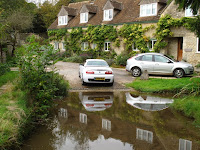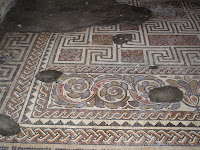 Today we were in the area, and a grade 2 bore was due at 9am, 10 minutes from our hotel in Stonehouse. It was the perfect occasion to get the general idea of what the bore looks like, at a civilized time of day. We arrived in good time at 'Stonebench', one of the places recommended on the Severn Bore official website.
Today we were in the area, and a grade 2 bore was due at 9am, 10 minutes from our hotel in Stonehouse. It was the perfect occasion to get the general idea of what the bore looks like, at a civilized time of day. We arrived in good time at 'Stonebench', one of the places recommended on the Severn Bore official website.  Unfortunately, we learnt that their website is rather out of date in recommending this spot. It used to be good when a large underwater stone bench made the water jump at this point, but although this slab (the Stonebench) was removed some time ago, they haven't changed the website! Some helpful surfies who were waiting there to catch the wave, recommended we wait at
Unfortunately, we learnt that their website is rather out of date in recommending this spot. It used to be good when a large underwater stone bench made the water jump at this point, but although this slab (the Stonebench) was removed some time ago, they haven't changed the website! Some helpful surfies who were waiting there to catch the wave, recommended we wait at  Maisemore bridge. The website said it would pass through there at 9.19am, so we had time to get there. But 9.19 came and went, with no sign of a wave. Fortunately a local came down to show some visitors the Bore, and told us it was running 20 minutes late. It finally came through about 9.55am and was worth the wait.. A grade 4 Bore must be most impressive.
Maisemore bridge. The website said it would pass through there at 9.19am, so we had time to get there. But 9.19 came and went, with no sign of a wave. Fortunately a local came down to show some visitors the Bore, and told us it was running 20 minutes late. It finally came through about 9.55am and was worth the wait.. A grade 4 Bore must be most impressive.We spent the rest of the day on two circular drives in the area.
 The highlights of these were a walk from Duntisbourne Abbots to Duntisbourne Leer. There are four villages along the Dunt stream, each village has a ford, which apart from the picturesque cottages, makes the villages especially appealing. The biggest town is Duntisbourne Abbots where started the walk, and the ford runs along the road between this village and Duntisbourne Leer for about 20m.
The highlights of these were a walk from Duntisbourne Abbots to Duntisbourne Leer. There are four villages along the Dunt stream, each village has a ford, which apart from the picturesque cottages, makes the villages especially appealing. The biggest town is Duntisbourne Abbots where started the walk, and the ford runs along the road between this village and Duntisbourne Leer for about 20m.  These days it is classed as unsuitable for vehicles, but in the days of horses and carts, it apparently cleaned the cart wheels. The route wound back to Cirencester, which we seem to have missed on any travels in the area. It is a stunning town, and a photographers delight. The stately home of Lord Bathurst, the local gentry, is surrounded by a hedge planted in 1720, and now claims to be the tallest yew hedge in Europe. Needless to say, there were no glimpses of the house.
These days it is classed as unsuitable for vehicles, but in the days of horses and carts, it apparently cleaned the cart wheels. The route wound back to Cirencester, which we seem to have missed on any travels in the area. It is a stunning town, and a photographers delight. The stately home of Lord Bathurst, the local gentry, is surrounded by a hedge planted in 1720, and now claims to be the tallest yew hedge in Europe. Needless to say, there were no glimpses of the house.
The route headed to Birdlip on a dead straight former Roman road. There are many Roman roads
 leading from Cirencester, as it was second only in importance to London in Roman times. The Birdlip area has stunning hillsides covered in beech trees, now turning golden. We visited two of the viewpoints in the area, with views across to Wales.
leading from Cirencester, as it was second only in importance to London in Roman times. The Birdlip area has stunning hillsides covered in beech trees, now turning golden. We visited two of the viewpoints in the area, with views across to Wales.C
 onsidering the importance of Cirencester in Roman times, it's not surprising that a number of Romans ruins have been discovered. We ended the day by visiting Chedworth Roman Villa. There are some partial mosaic tile floors and outlines of various rooms, with parts still visible of their underfloor heating and sophisticated bathrooms. The villa is interesting, but far more stunning is the beautiful drive there looking across at the golden beech clad hills.
onsidering the importance of Cirencester in Roman times, it's not surprising that a number of Romans ruins have been discovered. We ended the day by visiting Chedworth Roman Villa. There are some partial mosaic tile floors and outlines of various rooms, with parts still visible of their underfloor heating and sophisticated bathrooms. The villa is interesting, but far more stunning is the beautiful drive there looking across at the golden beech clad hills.




No comments:
Post a Comment